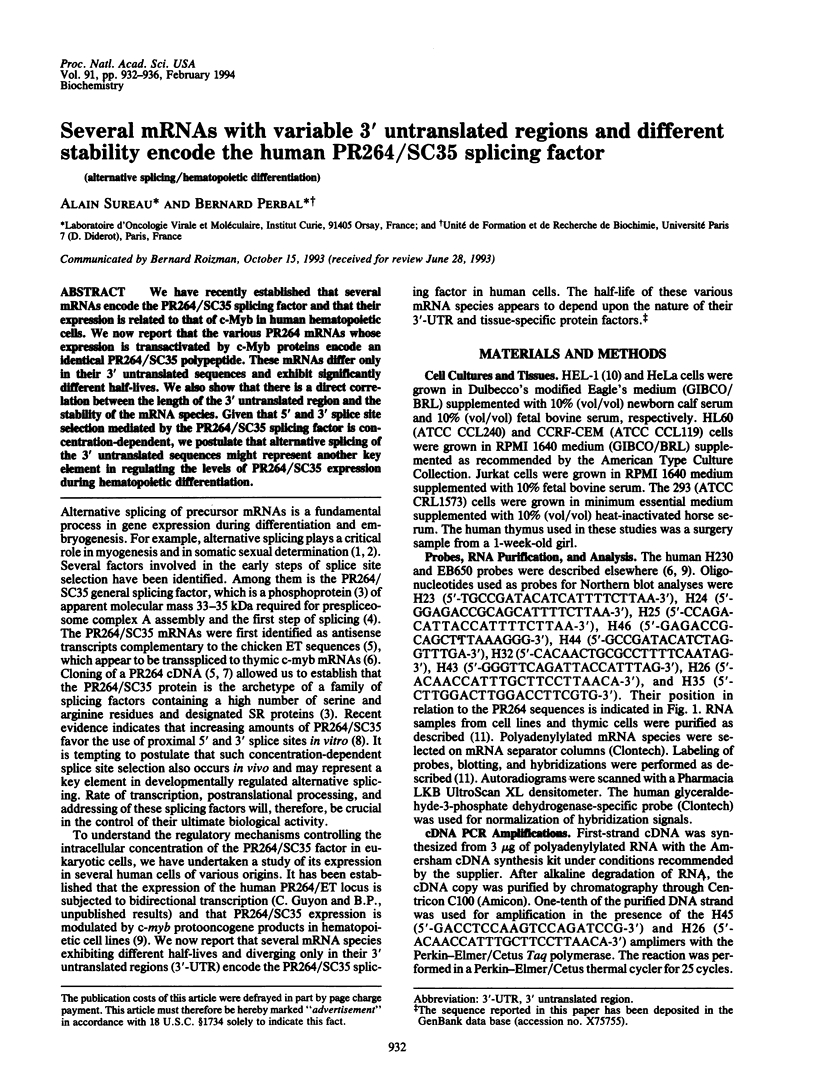Abstract
We have recently established that several mRNAs encode the PR264/SC35 splicing factor and that their expression is related to that of c-Myb in human hematopoietic cells. We now report that the various PR264 mRNAs whose expression is transactivated by c-Myb proteins encode an identical PR264/SC35 polypeptide. These mRNAs differ only in their 3' untranslated sequences and exhibit significantly different half-lives. We also show that there is a direct correlation between the length of the 3' untranslated region and the stability of the mRNA species. Given that 5' and 3' splice site selection mediated by the PR264/SC35 splicing factor is concentration-dependent, we postulate that alternative splicing of the 3' untranslated sequences might represent another key element in regulating the levels of PR264/SC35 expression during hematopoietic differentiation.
Full text
PDF




Images in this article
Selected References
These references are in PubMed. This may not be the complete list of references from this article.
- Atwater J. A., Wisdom R., Verma I. M. Regulated mRNA stability. Annu Rev Genet. 1990;24:519–541. doi: 10.1146/annurev.ge.24.120190.002511. [DOI] [PubMed] [Google Scholar]
- Azzarone B., Malpièce Y., Zaech P., Moretta L., Fauci A., Suarez H. Analysis of the expression of the 4F2 surface antigen in normal and neoplastic fibroblastic human cells of embryonic and adult origin. Exp Cell Res. 1985 Aug;159(2):451–462. doi: 10.1016/s0014-4827(85)80018-5. [DOI] [PubMed] [Google Scholar]
- Fu X. D., Maniatis T. Factor required for mammalian spliceosome assembly is localized to discrete regions in the nucleus. Nature. 1990 Feb 1;343(6257):437–441. doi: 10.1038/343437a0. [DOI] [PubMed] [Google Scholar]
- Fu X. D., Maniatis T. Isolation of a complementary DNA that encodes the mammalian splicing factor SC35. Science. 1992 Apr 24;256(5056):535–538. doi: 10.1126/science.1373910. [DOI] [PubMed] [Google Scholar]
- Fu X. D., Mayeda A., Maniatis T., Krainer A. R. General splicing factors SF2 and SC35 have equivalent activities in vitro, and both affect alternative 5' and 3' splice site selection. Proc Natl Acad Sci U S A. 1992 Dec 1;89(23):11224–11228. doi: 10.1073/pnas.89.23.11224. [DOI] [PMC free article] [PubMed] [Google Scholar]
- Hodgkin J. Sex determination compared in Drosophila and Caenorhabditis. Nature. 1990 Apr 19;344(6268):721–728. doi: 10.1038/344721a0. [DOI] [PubMed] [Google Scholar]
- Ichiyoshi Y., Endo H., Yamamoto M. Length polymorphism in the 3' noncoding region of rat hepatic alpha 2u-globulin mRNAs. Biochim Biophys Acta. 1987 Oct 9;910(1):43–51. doi: 10.1016/0167-4781(87)90093-5. [DOI] [PubMed] [Google Scholar]
- Libri D., Balvay L., Fiszman M. Y. In vivo splicing of the beta tropomyosin pre-mRNA: a role for branch point and donor site competition. Mol Cell Biol. 1992 Jul;12(7):3204–3215. doi: 10.1128/mcb.12.7.3204. [DOI] [PMC free article] [PubMed] [Google Scholar]
- Mancebo R., Lo P. C., Mount S. M. Structure and expression of the Drosophila melanogaster gene for the U1 small nuclear ribonucleoprotein particle 70K protein. Mol Cell Biol. 1990 Jun;10(6):2492–2502. doi: 10.1128/mcb.10.6.2492. [DOI] [PMC free article] [PubMed] [Google Scholar]
- Nakamura S., Nabeshima Y., Kobayashi H., Nabeshima Y., Nonomura Y., Fujii-Kuriyama Y. Single chicken cardiac myosin alkali light-chain gene generates two different mRNAs by alternative splicing of a complex exon. J Mol Biol. 1988 Oct 20;203(4):895–904. doi: 10.1016/0022-2836(88)90115-5. [DOI] [PubMed] [Google Scholar]
- Perbal B., Vellard M. Intermolecular recombination of the c-myb proto-oncogene coding sequences in chicken: clues for a mechanism. C R Acad Sci III. 1990;311(13):467–472. [PubMed] [Google Scholar]
- Rastinejad F., Blau H. M. Genetic complementation reveals a novel regulatory role for 3' untranslated regions in growth and differentiation. Cell. 1993 Mar 26;72(6):903–917. doi: 10.1016/0092-8674(93)90579-f. [DOI] [PubMed] [Google Scholar]
- Shaw G., Kamen R. A conserved AU sequence from the 3' untranslated region of GM-CSF mRNA mediates selective mRNA degradation. Cell. 1986 Aug 29;46(5):659–667. doi: 10.1016/0092-8674(86)90341-7. [DOI] [PubMed] [Google Scholar]
- Sureau A., Soret J., Vellard M., Crochet J., Perbal B. The PR264/c-myb connection: expression of a splicing factor modulated by a nuclear protooncogene. Proc Natl Acad Sci U S A. 1992 Dec 15;89(24):11683–11687. doi: 10.1073/pnas.89.24.11683. [DOI] [PMC free article] [PubMed] [Google Scholar]
- Vellard M., Soret J., Viegas-Pequignot E., Galibert F., Nguyen V. C., Dutrillaux B., Perbal B. C-myb proto-oncogene: evidence for intermolecular recombination of coding sequences. Oncogene. 1991 Apr;6(4):505–514. [PubMed] [Google Scholar]
- Vellard M., Sureau A., Soret J., Martinerie C., Perbal B. A potential splicing factor is encoded by the opposite strand of the trans-spliced c-myb exon. Proc Natl Acad Sci U S A. 1992 Apr 1;89(7):2511–2515. doi: 10.1073/pnas.89.7.2511. [DOI] [PMC free article] [PubMed] [Google Scholar]
- Wickens M. Messenger RNA. Springtime in the desert. Nature. 1993 May 27;363(6427):305–306. doi: 10.1038/363305a0. [DOI] [PubMed] [Google Scholar]
- Zahler A. M., Lane W. S., Stolk J. A., Roth M. B. SR proteins: a conserved family of pre-mRNA splicing factors. Genes Dev. 1992 May;6(5):837–847. doi: 10.1101/gad.6.5.837. [DOI] [PubMed] [Google Scholar]
- Zahler A. M., Neugebauer K. M., Lane W. S., Roth M. B. Distinct functions of SR proteins in alternative pre-mRNA splicing. Science. 1993 Apr 9;260(5105):219–222. doi: 10.1126/science.8385799. [DOI] [PubMed] [Google Scholar]





